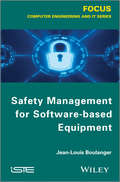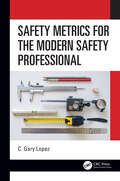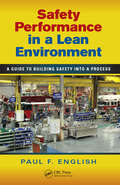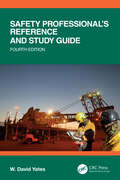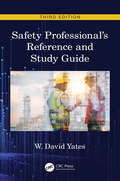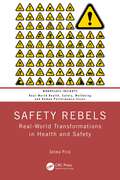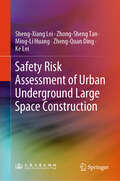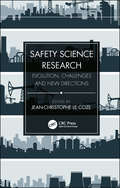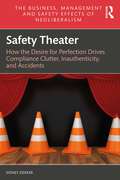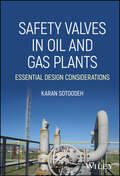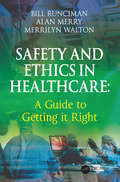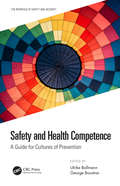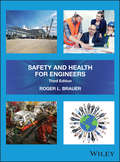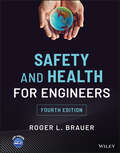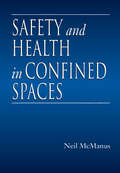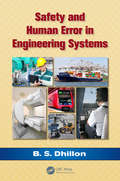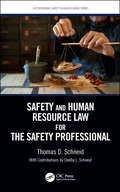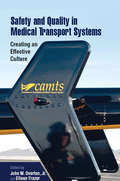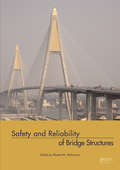- Table View
- List View
Safety Management: A Qualitative Systems Approach
by John Davies Alastair Ross Brendan WallaceProfessionals striving for accident reduction must deal with systems in which both technical and human elements play equal and complementary roles. However, many of the existing techniques in ergonomics and risk management concentrate on plant and technical issues and downplay human factors and "subjectivity." Safety Management: A Qualitative Systems Approach describes a body of theories and data that addresses safety by drawing on systems theory and applied psychology, stressing the importance of human activity within systems. It explains in detail the central roles of social consensus and reliability and the nature of verbal reports and functional discourse.This text presents a new approach to safety management, offering a path to both greater safety and to economic savings. It presents a series of methodological tools that have proven to be reliable through extensive use in the rail and nuclear industries. These methods allow organizational and systems failures to be analyzed much more effectively in terms of quantity, precision, and usefulness. The concepts and tools described in this book are particularly valuable for reliability engineers, risk managers, human factors specialists, and safety managers and professionals in safety-critical organizations.
Safety Management: Near Miss Identification, Recognition, and Investigation (Workplace Safety, Risk Management, and Industrial Hygiene)
by Ron C. McKinnonClose calls, narrow escapes, or near hits. History has shown repeatedly that these "near-miss" incidents often precede loss producing events, but are largely ignored or go unreported because nothing (no injury, damage or loss) happened. Thus, many opportunities to prevent the accidents that the organization has not yet had are lost. Recognizing and
Safety Management for Software-based Equipment (Focus Ser.)
by Jean-Louis BoulangerA review of the principles of the safety of software-based equipment, this book begins by presenting the definition principles of safety objectives. It then moves on to show how it is possible to define a safety architecture (including redundancy, diversification, error-detection techniques) on the basis of safety objectives and how to identify objectives related to software programs. From software objectives, the authors present the different safety techniques (fault detection, redundancy and quality control). “Certifiable system” aspects are taken into account throughout the book. Contents 1. Safety Management. 2. From System to Software. 3. Certifiable Systems. 4. Risk and Safety Levels. 5. Principles of Hardware Safety. 6. Principles of Software Safety. 7. Certification. About the Authors Jean-Louis Boulanger is currently an Independent Safety Assessor (ISA) in the railway domain focusing on software elements. He is a specialist in the software engineering domain (requirement engineering, semi-formal and formal method, proof and model-checking). He also works as an expert for the French notified body CERTIFER in the field of certification of safety critical railway applications based on software (ERTMS, SCADA, automatic subway, etc.). His research interests include requirements, software verification and validation, traceability and RAMS with a special focus on SAFETY.
Safety Metrics for the Modern Safety Professional
by C. Gary LopezThis book investigates the world of leading indicators and explores how they can be used effectively, providing 21st-century safety professionals with alternative metrics and guidance, which will enable them to make a difference in managing risk within an organization. The safety and health profession has been hindered by ineffective metrics for decades, with the primary metrics of choice being the OSHA incident rate and lost time accident rate. This narrow focus on what constitutes loss is not in line with the new concepts of managing the total risk that an organization faces. The book looks at indicators on a tactical level where they can be very effective in providing management with clear direction and "manageable" items they can utilize to elevate the safety efforts of an organization. It also explores the limitations of leading indicators at the strategic level and how they’re tied into the management merit review system to determine bonus and salary increase structures. It features measurements of areas of loss not usually considered by safety managers, suggests ways to use leading indicators, and promotes a departure from traditional "body count" thinking. This book will be of interest to safety professionals involved in risk management in the modern workplace.
Safety Performance in a Lean Environment: A Guide to Building Safety into a Process (Occupational Safety & Health Guide Series)
by Paul F. EnglishAs changing customer demands and shifting world markets continue to put a strain on businesses in all sectors, your business needs every advantage to stay competitive. Many people may think of Lean processes as suitable only for the manufacturing floor, but that couldn't be further from the truth. Safety Performance in a Lean Environment: A Guide t
Safety Professional's Reference and Study Guide
by W. David YatesWhile there are numerous technical resources available, often you have to search through a plethora of them to find the information you use on a daily basis. And maintaining a library suitable for a comprehensive practice can become quite costly. The new edition of a bestseller, Safety Professional's Reference and Study Guide, Second Edition provides a single-source reference that contains all the information required to handle the day-to-day tasks of a practicing industrial hygienist. New Chapters in the Second Edition cover: Behavior-based safety programs Safety auditing procedures and techniques Environmental management Measuring health and safety performance OSHA’s laboratory safety standard Process safety management standard BCSPs Code of Ethics The book provides a quick desk reference as well as a resource for preparations for the Associate Safety Professional (ASP), Certified Safety Professional (CSP), Occupational Health and Safety Technologist (OHST), and the Construction Health and Safety Technologist (CHST) examinations. A collection of information drawn from textbooks, journals, and the author’s more than 25 years of experience, the reference provides, as the title implies, not just a study guide but a reference that has staying power on your library shelf.
Safety Professional's Reference and Study Guide, Fourth Edition
by W. David YatesFor safety professionals navigating the complexities of safety practices daily, the search for a single-source guide covering diverse topics has been an ongoing quest. Now, in its fourth edition, Safety Professional’s Reference and Study Guide has expanded its scope, incorporating crucial new chapters on legal aspects of the safety profession, recordkeeping, sustainability principles, and more, catering to the evolving needs of the Environmental Health and Safety (EHS) community.This title is every safety professional’s indispensable, market-leading resource, empowering the reader to tackle challenges with confidence and expertise. Exploring core aspects of occupational safety, this book offers a wealth of knowledge, each chapter offering practical insights and actionable advice. The title goes beyond conventional boundaries, addressing emerging topics such as electrical safety, risk assessment, and sustainability principles in brand-new chapters.A go-to guide for any practicing safety professional seeking a quick desk reference, a student supplementing their textbooks, or a candidate preparing for certification exams including ASP, CSP, OHST or CHST, it equips readers with the knowledge and skills needed to navigate the evolving landscape of occupational safety focusing on real-world applications and exam readiness.
Safety Professional's Reference and Study Guide, Third Edition
by W. David YatesThis new edition serves both as a reference guide for the experienced professional and as a preparation source for those desiring certifications. It’s an invaluable resource and a must-have addition to every safety professional’s library. Safety Professional’s Reference and Study Guide, Third Edition, is written to serve as a useful reference tool for the experienced practicing safety professional, as well as a study guide for university students and those preparing for the Certified Safety Professional examination. It addresses major topics of the safety and health profession and includes the latest version of the Board of Certified Safety Professional (BCSP) reference sheet, a directory of resources and associations, as well as state and federal agency contact information. Additionally, this new edition offers new chapters and resources that will delight every reader. This book aids the prospective examination candidate and the practicing safety professional, by showing them, step-by-step, how to solve each question/formula listed on the BCSP examination and provide examples on how and when to utilize them.
Safety Rebels: Real-World Transformations in Health and Safety (Workplace Insights)
by Selma PirićSafety Rebels: Real-World Transformations in Health and Safety discusses the pragmatic experiences of over 30 safety professionals worldwide who managed to positively transform safety within their organizations. This book details the approaches taken while considering the politics and dynamics within each organization, including resistance to change, deteriorating safety statistics, increased number of procedures for operational personnel, high turnover, and budget restrictions.Professionals from the world of aerospace, healthcare, energy, oil, rail, and public services share their experiences of positive safety change, revealing transformations in different contexts. This book explains key safety principles, theories, and shared models. It reveals how the professionals applied state-of-the-art knowledge, Safety-II, FRAM, incident data, and artificial intelligence into their organization to prevent personnel from working in a silo. It includes relevant safety and multidisciplinary theories, from Heinrich’s incident model to resilience engineering, as well as aspects of change management and human organizational performance (HOP). These theories offer the reader a framework to try something new, and this book will inspire them to try contemporary strategies and tactics to approach safety challenges within any organization.This timely and easy-to-read book will appeal to professionals in the field of health and safety. It will have particular appeal to those working in Industrial Engineering, Aerospace Engineering, Nuclear Engineering, Mechanical Engineering, Civil Engineering, Chemical Engineering, Biomedical Engineering, and Electrical Engineering.
Safety Risk Assessment of Urban Underground Large Space Construction
by Sheng-Xiang Lei Zhong-Sheng Tan Ming-Li Huang Zheng-Quan Ding Ke LeiThis monograph aims to provide theoretical and technical support for construction safety risk assessment in the construction of urban underground large space, since high construction risks and safety accidents frequently occurs in the current development of complex underground spaces in urban areas. The author's team completes the statistical analysis on a large number of typical engineering instances and related accident cases, and proposes the definition of "urban underground large space" and corresponding risk analysis methods. This book starts with analyzing the safety risk characteristics during construction period of urban underground large spaces and establishes a coupling evolution analysis model, then proposes an index system and the quantitative criterion for construction safety risk assessment in urban underground large space, and lastly constructs a dynamic evaluation system on construction safety risk. The book will be an valuable reference for professional engineers, researchers, teachers, and students with an interest in the construction and management of underground spaces. The basis of English translation of this book, originally in Chinese, was facilitated by artificial intelligence. The content was later revised by the authors for accuracy.
Safety Science Research: Evolution, Challenges and New Directions
by Jean-Christophe Le CozeSafety Science Research: Evolution, Challenges and New Directions provides a unique perspective into the latest developments of safety science by putting together, for the first time, a new generation of authors with some of the pioneers of the field. Forty years ago, research traditions were developed, including, among others, high-reliability organisations, cognitive system engineering or safety regulations. In a fast-changing world, the new generation introduces, in this book, new disciplinary insights, addresses contemporary empirical issues, develops new concepts and models while remaining critical of safety research practical ambitions. Their ideas are then reflected and discussed by some of the pioneers of safety science. Features Allows the reader to discover how contemporary safety issues are currently framed by a new generation of researchers, brought together for the first time Includes an introduction and guide to the development of safety science over the last four decades Features an extraordinary collection of expert contributors, including pioneers of safety research, reflecting the evolution of the discipline and offering insightful commentary on the current and future state of the field Serves as an invaluable reference and guide for safety professionals and students from any established disciplines such as sociology, engineering, psychology, political science or management as well as dedicated safety programmes Some figures in the eBook are in colour
Safety Theater: How the Desire for Perfection Drives Compliance Clutter, Inauthenticity, and Accidents (The Business, Management and Safety Effects of Neoliberalism)
by Sidney DekkerHow is it possible that the desire for a perfectly safe world with perfectly safe workplaces helps generate the opposite? Safety Theater shows how our desire for perfection drives compliance clutter, inauthentic relationships with work-as-done, and new kinds of accidents. Written by the leading global voice on safety innovation today, Safety Theater takes us back to the Enlightenment and its aspiration toward a perfectible world through rationality and science, and explains how, by separating severity from injury rates two centuries later, we now hit our targets but miss the point. This hopeful, forward-looking book is the final volume in a three-part series on the effects of "neoliberalism," which promotes the role of the private sector in the economy.Showcasing a more caring kind of capitalism—where free markets are free in a frame; where horizontal coordination replaces hierarchical control; where shareholders are not the only stakeholders; and where value and prosperity are assessed in terms other than merely economic ones—the book platforms much of what is now known as "safety differently," and also allows us to think differently about our capacity to manage complexity (including its possible drift toward failure) and see our fellow human beings as resources for solutions, not as problems to control. Safety Theater introduces the socio-economic success and value system that distinguish Rhineland economies from Anglo ones. It explains how complexity can never be governed through hierarchy and compliance, but necessarily requires trust and horizontal coordination; offers a vision of humanity richer than Anglo-style capitalism can offer; and examines how Rhineland thinking values tripartite consultation (between workers, employers, and government) in ways that can help stem the worst effects of free market policymaking on the compliance clutter and drift into failure, as detailed in the previous two volumes in this trilogy.Sidney Dekker’s work—from his debut Field Guide to Understanding Human Error in 2001 to his recent Random Noise—always challenges readers to embrace more humane, empowering ways to think about work and its quality and safety. In Safety Theater, Dekker extends his reach once again, writing for all managers, board members, organization leaders, consultants, practitioners, researchers, lecturers, students, and investigators curious to understand the genuine nature of organizational and safety performance.
Safety Valves in Oil and Gas Plants: Essential Design Considerations
by Karan SotoodehComprehensive approach to designing safety valves used in oil and gas plants, featuring case studies throughout the text Safety Valves in Oil and Gas Plants delivers a comprehensive overview of the various aspects of safety valves in the oil and gas industries, including their design and accessories. To help reinforce learning, case studies included throughout the text and multiple-choice questions and answers are included at the end of each chapter. Written by an industry veteran with extensive publishing and speaking experience, this book includes information on: Design details such as sizing and reaction forces, inspection, maintenance, codes and standards, and packing and preservationDaily industrial challenges regarding the resizing of existing pressure safety valves (PSVs) or the proper sizing of new PSVsProcess safety standards for all new operative installations or existing ones in the chemical industryCatalysts that can increase the pressure of fluids, including human error and equipment and component failureThe role of safety valves in protecting properties, the environment, and human life This is an excellent reference on the subject for engineers and advanced students in chemical and process engineering, mechanical engineering, piping and valve engineering, and safety and instrument engineering.
Safety and Ethics in Healthcare: A Guide To Getting It Right
by Alan Merry Bill Runciman Merrilyn WaltonAs more and more people survive into old age, the burden of caring for them becomes greater and greater. Although it is now possible to alleviate many of the afflictions that beset mankind, no society can afford to pay for all the healthcare that is now available or technically possible. People working in healthcare increasingly have to do more with less. Rationing takes many forms, mostly covert, and the less privileged in most societies end up struggling to get their proper share of the available healthcare resources. All too often, those in the front-line have to deal with the consequences of this 'rationing by default': healthcare professionals find themselves rushed off their feet simply doing the basic tasks and completing all the paperwork; placing frail, sick people in ever lengthening queues, sometimes asking them to wait for hours in the middle of the night under uncomfortable and even unsafe conditions; and, worst of all, working under conditions they would rather avoid in which the safety margin for those they are caring for has been greatly diminished. We are all aware that under these conditions the chance of making a mistake which can seriously harm or even lead to the death of a patient is greatly increased. But what can be done about this? How can you be sure that you are doing the right thing when faced with having to practise an uncertain science on vulnerable patients in a complex system under ever-changing conditions? At what point could you cross the invisible line from reasonable to irresponsible or unethical behaviour by tolerating conditions or tacitly accepting practices which may be regarded as unacceptable, even though you may have little immediate control over them? This book is a guide to getting it right for healthcare professionals. It is about doing the right thing, in the right way, at the right time, for the right people. These are the dimensions of quality in healthcare, and although some are in conflict (equitable access and efficiency, for example), adherence to ethical practice and professional behaviour will help lead healthcare practitioners through the minefield of responsibilities and priorities. Real-life situations are integral to the book, with over 500 clinical examples referred to within the text.
Safety and Health Competence: A Guide for Cultures of Prevention (The Interface of Safety and Security)
by Ulrike Bollmann and George BoustrasGlobal and technological transformation is changing work and learning. A broader understanding of prevention and cultural change associated with it is putting new demands on companies and their employees. People and organizations need suitable competences to deal with this transformation. They need to be empowered to shape decent living and working conditions. Safety and Health Competence: A Guide for Cultures of Prevention is written in the context of work and health. The use of a social-constructive and a context sensitive approach to competence in occupational safety and health is new and forms a theoretical basis for putting into place the necessary learning processes for cultural transformation in companies and educational institutions. Covers a broad range of new demands placed on companies and employees in this age of global and technological transformation Provides assistance with a better understanding of the current debate on occupational safety and health (OSH) competences Presents a comprehensive source of information for OSH experts, human resource specialists, educational institutions, training development specialists, teachers, and trainers, allowing them to identify competence needs, promote competence development, and assess competences Explains what the concept culture of prevention means Offers real-life examples that will appeal to practitioners
Safety and Health for Engineers
by Roger L. BrauerSafety and Health for Engineers, 3rd Edition, addresses the fundamentals of safety, legal aspects, hazard recognition and control, and techniques for managing safety decisions, as well as: Completely revises and updates all 38 chapters in the book New edition adds more than 110 stories and cases from practice to illustrate various topics or issues New topics on adapting to new safety concerns that arise from technology innovations; convergence of safety, health and environmental departments in many organizations; the concept of prevention through design; and emphasis on safety management systems and risk management and analysis Includes learning exercises and computational examples based on real world situations along with in-depth references for each chapter Includes a detailed solutions manual for academic adopters Covers the primary topics included in certification exams for professional safety, such as CSP/ASP
Safety and Health for Engineers
by Roger L. BrauerSAFETY AND HEALTH FOR ENGINEERS A comprehensive resource for making products, facilities, processes, and operations safe for workers, users, and the public Ensuring the health and safety of individuals in the workplace is vital on an interpersonal level but is also crucial to limiting the liability of companies in the event of an onsite injury. The Bureau of Labor Statistics reported over 4,700 fatal work injuries in the United States in 2020, most frequently in transportation-related incidents. The same year, approximately 2.7 million workplace injuries and illnesses were reported by private industry employers. According to the National Safety Council, the cost in lost wages, productivity, medical and administrative costs is close to 1.2 trillion dollars in the US alone. It is imperative—by law and ethics—for engineers and safety and health professionals to drive down these statistics by creating a safe workplace and safe products, as well as maintaining a safe environment. Safety and Health for Engineers is considered the gold standard for engineers in all specialties, teaching an understanding of many components necessary to achieve safe workplaces, products, facilities, and methods to secure safety for workers, users, and the public. Each chapter offers information relevant to help safety professionals and engineers in the achievement of the first canon of professional ethics: to protect the health, safety, and welfare of the public. The textbook examines the fundamentals of safety, legal aspects, hazard recognition and control, the human element, and techniques to manage safety decisions. In doing so, it covers the primary safety essentials necessary for certification examinations for practitioners. Readers of the fourth edition of Safety and Health for Engineers readers will also find: Updates to all chapters, informed by research and references gathered since the last publication The most up-to-date information on current policy, certifications, regulations, agency standards, and the impact of new technologies, such as wearable technology, automation in transportation, and artificial intelligence New international information, including U.S. and foreign standards agencies, professional societies, and other organizations worldwide Expanded sections with real-world applications, exercises, and 164 case studies An extensive list of references to help readers find more detail on chapter contents A solution manual available to qualified instructors Safety and Health for Engineers is an ideal textbook for courses in safety engineering around the world in undergraduate or graduate studies, or in professional development learning. It also is a useful reference for professionals in engineering, safety, health, and associated fields who are preparing for credentialing examinations in safety and health.
Safety and Health in Composite Industry (Composites Science and Technology)
by R.A. Ilyas S.M. Sapuan M.R.M. AsyrafThis book provides the latest developments on safety practices utilized in composite manufacturing facilities for students, workers, engineers, and other participants. It includes commentary from academic experts in the field who present cutting-edge research on advanced composite materials. Illustrations, figures, and tables are included in this book in order to make it easier for students, workers, engineers, and other participants to understand the contents of this book. The end user knows the safety and health that should be practiced in composite industry and their right in composite industry. Besides that, the composites industry players can upgrade their current safety system to the recommended practiced system. A lot of problems are solved by integrate the current system and advanced technology system from extensive research.
Safety and Health in Confined Spaces
by Neil McManusSafety and Health in Confined Spaces goes beyond all other resources currently available. International in scope, the 15 chapters and 10 appendices cover every facet of this important subject. A significant addition to the literature, this book provides a confined space focus to other health and safety concepts.Confined spaces differ from other workspaces because their boundary surfaces amplify the consequences of hazardous conditions. The relationship between the individual, the boundary surface, and the hazardous condition is the critical factor in the onset, outcome, and severity of accidents in these workspaces.The author uses information about causative and other factors from analysis of fatal accidents to develop a hazard assessment and hazard management system. He provides a detailed, disciplined protocol, covering 36 hazardous conditions, that addresses all segments of work--the undisturbed space, entry preparation, work activity, and emergency preparedness and response--and illustrates how to use it. Safety and Health in Confined Spaces gives you the tools you need for preventing and responding to accidents.
Safety and Human Error in Engineering Systems
by B.S. DhillonIn an approach that combines coverage of safety and human error into a single volume, Safety and Human Error in Engineering Systems eliminates the need to consult many different and diverse sources for those who need information about both topics. The book begins with an introduction to aspects of safety and human error and a discussion of mathemat
Safety and Human Resource Law for the Safety Professional (Occupational Safety & Health Guide Series)
by Thomas SchneidThe purpose of this text to provide a "one stop" source for safety professionals to acquire a general knowledge regarding not only the OSH Act but also laws and standards which impact the safety profession on a daily basis. The safety professional today does not work in a vacuum and decision-making can be impacted by a myriad of other laws. This new book will be the safety professional’s "go to" text to acquire a quick understanding of the particular law potentially impacting his/her daily activities. <p><p>Features <li>Includes safety laws as well as human resource laws <li>Presents new OSHA whistleblower actions <li>Encompasses updated contractor requirement under Wage and Hour laws <li>Covers new NLRA decisions and actions <li>Addresses e-commerce and social media issues involving the safety function
Safety and Quality in Medical Transport Systems: Creating an Effective Culture
by John W. Overton Eileen FrazerThe Commission on Accreditation of Medical Transport Systems (CAMTS) has been accrediting air and ground transport services since 1991. One of the most significant needs the Commission has recognized is to assist transport services in creating a culture that supports safety and quality for both crews and patients. Most of the helicopter EMS (emergency medical service) accidents and many ground ambulance accidents can be attributed to human factors and systems designs that lead to poor decision-making. Management commitment is vital to create and maintain a culture that supports risk assessment, accountability, professionalism and organizational dynamics. This reference book has been created by CAMTS to address this need directly and comprehensively. It offers a groundbreaking collection of expert insights and practical solutions that can be used by EMS, Fire and Rescue, public and private services, and professional emergency and transport professionals worldwide. Quoting from the foreword written by the late Robert L. Helmreich, Professor Emeritus of Psychology at The University of Texas Human Factors Research Project, 'This is an important book which should be required reading for everyone involved in patient transport, from managers and dispatchers to those at the sharp end... The experienced and able authors and editors of this work use culture as the overarching concept needed to maximize safety while delivering patients expeditiously.'
Safety and Reliability in the Oil and Gas Industry: A Practical Approach
by B.S. DhillonAn Insightful Guide to Avoiding Offshore Oil- and Gas-Industry Disaster Designing, constructing, operating, and maintaining offshore oil and gas industry equipment and systems can sometimes result in accidents, injuries, and other serious problems. Safety and Reliability in the Oil and Gas Industry: A Practical Approach focuses on oil and gas indus
Safety and Reliability of Bridge Structures
by Khaled M. MahmoudRecent surveys of the U.S. infrastructure‘s condition have rated a staggering number of bridges structurally deficient or functionally obsolete. While not necessarily unsafe, a structurally deficient bridge must be posted for weight and have limits for speed, due to its deteriorated structural components. Bridges with old design features that canno
Safety and Reliability of Complex Engineered Systems: ESREL 2015
by Wolfgang Kröger Enrico Zio Luca Podofillini Bruno Sudret Božidar StojadinovićSafety and Reliability of Complex Engineered Systems contains the Proceedings of the 25th European Safety and Reliability Conference, ESREL 2015, held 7-10 September 2015 in Zurich, Switzerland. Including 570 papers on theories and methods in the area of risk, safety and reliability, and their applications to a wide range of industrial, civil and social sectors, this book will be of interest to academics and professionals involved or interested in aspect of risk, safety and reliability in various engineering areas.


